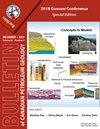地质注释Sukunka组:加拿大不列颠哥伦比亚省东北部一个新的中泥盆纪岩石地层单元
Q3 Earth and Planetary Sciences
引用次数: 0
摘要
“Sukunka组”一词是指位于不列颠哥伦比亚省东北部落基山脉前山脉中泥盆世岩层和达尼丁岩层之间的一个113 - 169米厚的硅-塑料和碳酸盐混合单元。该单元在苏昆卡河的源头附近发育最好,在那里它沿着一系列紧密间隔的叠瓦状逆冲构造出露。在字型区,可分为三个(非正式)成员:下、中、上。下段不整合覆于石组之上,由层间正石英岩、白云岩和砂质白云岩组成。中段上覆以砖红色风化粉砂岩为主,与少量白云岩互层。这些“红层”在野外很容易识别,也可以在该地区的其他地方用来识别逆冲叠瓦。上段由一系列厚至块状的层状、互层状、耐风化的干净石英砂岩组成,这些砂岩逐级覆盖在中段上。地层顶部也是不整合的。它被达尼丁组Dd-1段的基底钙质页岩和灰岩所侵和覆盖。然而,苏孔卡组的滞后沉积发生在Dd-1段的基底钙质页岩和灰岩中。这种情况被认为反映了水的上升导致了达尼丁组的堆积,导致了苏昆卡组地层水平向东进进。在苏昆卡组尚未发现诊断化石。目前仅根据地层位置,确定为中泥盆世早期。在地下,在石质地层和达尼丁地层之间的同一地层位置,还发现了未命名的泥质、砂质和粉质碳酸盐。再往东,这些可能相当于钦查加组中未命名的碎屑单元。本文章由计算机程序翻译,如有差异,请以英文原文为准。
GEOLOGICAL NOTE Sukunka Formation: a new Middle Devonian lithostratigraphic unit, northeastern British Columbia, Canada
Abstract The term “Sukunka Formation” is proposed for a 113 to 169 metre thick mixed siliciclastic and carbonate unit lying between the Middle Devonian Stone and Dunedin Formations in the Rocky Mountain Front Ranges of northeastern British Columbia. The unit is best developed near the headwaters of the Sukunka River, where it outcrops along a series of closely spaced imbricate thrusts. In the type area, it can be divided into three (informal) members: lower, middle and upper. The lower member overlies the Stone Formation unconformably and consists of inter-bedded orthoquartzite, dolostone and sandy dolostone. It is overlain by the middle member that consists predominantly of brick red weathering siltstones interbedded with minor amounts of dolostone. These ‘red beds’ are readily recognizable in the field and can be used elsewhere in the area to identify thrust imbricates. The upper member consists of a series of thick to massive bedded, well cross-bedded and resistant weathering clean quartzose sandstones which gradationally overlie the middle member. The top of the formation is also disconformable. It is transgressed and overlain by the basal calcareous shales and limes of the Dd-1 member of the Dunedin Formation. However, lag deposits from the Sukunka Formation occur within the basal calcareous shales and limes of the Dd-1 member. This condition is thought to reflect progressive transgression of higher stratigraphic levels of the Sukunka Formation to the east by the rising waters that led to accumulation of the Dunedin Formation. Diagnostic fossils have not been recognized in the Sukunka Formation. Presently, it is dated as early Middle Devonian based solely on stratigraphic position. In the subsurface, in the same stratigraphic position between the Stone and Dunedin formations, unnamed argillaceous, sandy and silty carbonates have also been identified. These, further to the east, may be equivalent to the unnamed detrital unit of the Chinchaga Formation.
求助全文
通过发布文献求助,成功后即可免费获取论文全文。
去求助
来源期刊

Bullentin of Canadian Petroleum Geology
Earth and Planetary Sciences-Geochemistry and Petrology
CiteScore
2.50
自引率
0.00%
发文量
0
期刊介绍:
The Bulletin of Canadian Petroleum Geology is a peer-reviewed scientific journal published four times a year. Founded in 1953, the BCPG aims to be the journal of record for papers dealing with all aspects of petroleum geology, broadly conceived, with a particularly (though not exclusively) Canadian focus. International submissions are encouraged, especially where a connection can be made to Canadian examples.
 求助内容:
求助内容: 应助结果提醒方式:
应助结果提醒方式:


